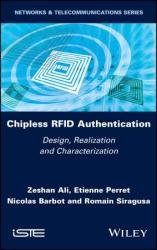 Название: Chipless RFID Authentication: Design, Realization and Characterization
Название: Chipless RFID Authentication: Design, Realization and CharacterizationАвтор: Zeshan Ali, Etienne Perret, Nicolas Barbot
Издательство: Wiley-ISTE
Год: 2022
Страниц: 220
Язык: английский
Формат: epub (true)
Размер: MB
Chipless RFID Authentication examines the development of highly secure product authentication systems for manufactured products by using chipless radio frequency identification (RFID) technology.
The absence of a chip and its compatibility with mass production make chipless RFID an alternative to barcodes. This book discusses how, by using natural randomness inherent to the fabrication process, each chipless RFID tag has a unique signature that can never be reproduced, even if someone tries to copy the label.
The book first explores the state-of-the-art of existing authentication and anti-counterfeiting methods based on their security level. Next, a methodology describing the characterization of chipless RFID tags for the authentication application is presented, followed by a discussion of the extraction of aspect-independent parameters for chipless RFID tags. After proposing designs for the tags, the book presents the realization and characterization of the labels (which exhibit naturally occurring randomness) for authentication, using printed circuit boards and inkjet printing on polyethylene terephthalate.
This book is focused on taking the next step with the aim of developing chipless tags for highly secure product authentication applications. The concept of conventional chipless radio frequency identification (RFID) is extended to the authentication where each tag has to present a unique signature that can never be reproduced even if someone tries to copy the tag. For this purpose, natural randomness (i.e. inherent in the fabrication process) along the dimensional parameters of resonators is used. Such natural randomness can produce unique electromagnetic (EM) signatures that can be used for authentication. First, a methodology to characterize the chipless RFID tag for authentication applications is presented. This methodology consists of procedures to conduct both authentication and statistical analyses. The capabilities of chipless technology to be used for tag discrimination are demonstrated by purposely applying the dimensional variations using two technologies: printed circuit board (PCB) and inkjet printing. Then, the extraction of aspect-independent parameters for chipless RFID tags is presented.
For authentication purposes, aspect-independent parameters are directly associated with the physical dimensions of the scatterer of a chipless tag, but not associated with the measurement procedure. The random variation of the physical dimensions of the scatterers is then associated with aspect-independent parameters, which is particularly promising for chipless authentication. On the other hand, with the operation of a single measurement, the proposed extraction of aspect-independent parameters is very promising for the practical implementation of the chipless RFID technology. Finally, chipless authentication methods using naturally occurring randomness in the realization process of PCB chipless tags and inkjet-printed polyethylene terephthalate (PET) chipless tags are presented. The optimization of chipless RFID tags for each realization technology (PCB and inkjet printing) is presented. This optimization is performed to exploit the natural process variations effectively for the purpose of authentication, unlike the conventional chipless RFID tags that are not capable of exploiting the variations effectively.
To prove this concept, sufficiently large populations of chipless RFID tags are taken. For PCB, chipless RFID tags are realized two times intermittently, where each realization consists of 45 tags. The two different realizations share the same company, the same PCB technology, but a different film mask, in order to ensure the natural dimensional randomness. Similarity analyses are conducted within each realization, as well as between two intermittent realizations. Finally, the technique is generalized to decrease the probability of error to a significant level. For inkjet-printed PET tags, an evolution of the probability of error is presented in comparison to the optimization of the design of chipless tags. The performance of the system is analyzed by a highly accurate vector network analyzer (VNA)-based reader and a low-cost impulse radio (IR) ultra-wideband (UWB) chipless reader. The probability of error achieved is comparable to the various fingerprint evaluation campaigns found in the literature.
Скачать Chipless RFID Authentication: Design, Realization and Characterization